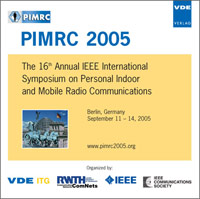Optimal HSDPA Multi-cell Power Allocation in a Moving Hotspot Scenario
Conference: PIMRC 2005 - 16th Annual IEEE International Symposium on Personal Indoor and Mobile Radio Communications
09/11/2005 - 09/14/2005 at Berlin, Germany
Proceedings: PIMRC 2005
Pages: 5Language: englishTyp: PDF
Personal VDE Members are entitled to a 10% discount on this title
Authors:
Abou-Jaoude, R.; Dillinger, M.; Mohyeldin, E.; Luo, J. (Siemens AG, St. Martin Str. 76, 81451 Munich, Germany)
Abou-Jaoude, R.; Hartmann, C. (Munich University of Technology, Institute of Communication Networks, 80290 Munich, Germany)
Koenig, W.; Loewel, T. (Alcatel R&I, Lorenzstr. 10, 70435 Stuttgart, Germany)
Abstract:
In the context of dynamic network management, the HSDPA power allocation in each cell is considered in this paper as a mean of assigning resources through a wireless network in an autonomic way. Under the umbrella of end-to-end reconfigurability as stated in the E2R EU funded project, dynamic management is enabled by allowing on the fly reconfiguration of network parameters, leading to an optimized use of resources and more flexibility in allocating resources of heterogeneous networks based on demand. The test scenario consists of a moving hotspot, where users are served by a high speed shared data channels. All available spreading codes are given to one user at a time, and a queuing model based on M/G/1-PS is used to evaluate the throughput and the response time both in the hotspot cell and the neighboring cells. A basic algorithm consisting of a total cell power allocation proportional to the number of user waiting to be served is investigated, of which gains in terms of hotspot throughput were proven to be higher than the losses incurring in neighboring and less populated cells. A typical scenario where the hotspot occurs is for example when users move to an area known to be crowded at a certain point of time during the day, but then move again to a neighboring area due to another interest there. The hotspot could also occur in an unexpected way (traffic jam, special events), and resources have to be adapted intelligently and autonomously. The efficiency of such an algorithm is investigated in terms of different parameters. Moreover, in the course of looking for a boundary for the performance of such an algorithm, we propose a simulated annealing based approach to find the optimal power distribution to evaluate the proximity of simpler and faster algorithms to such an optimum.


